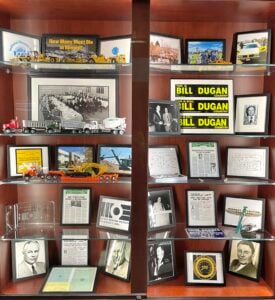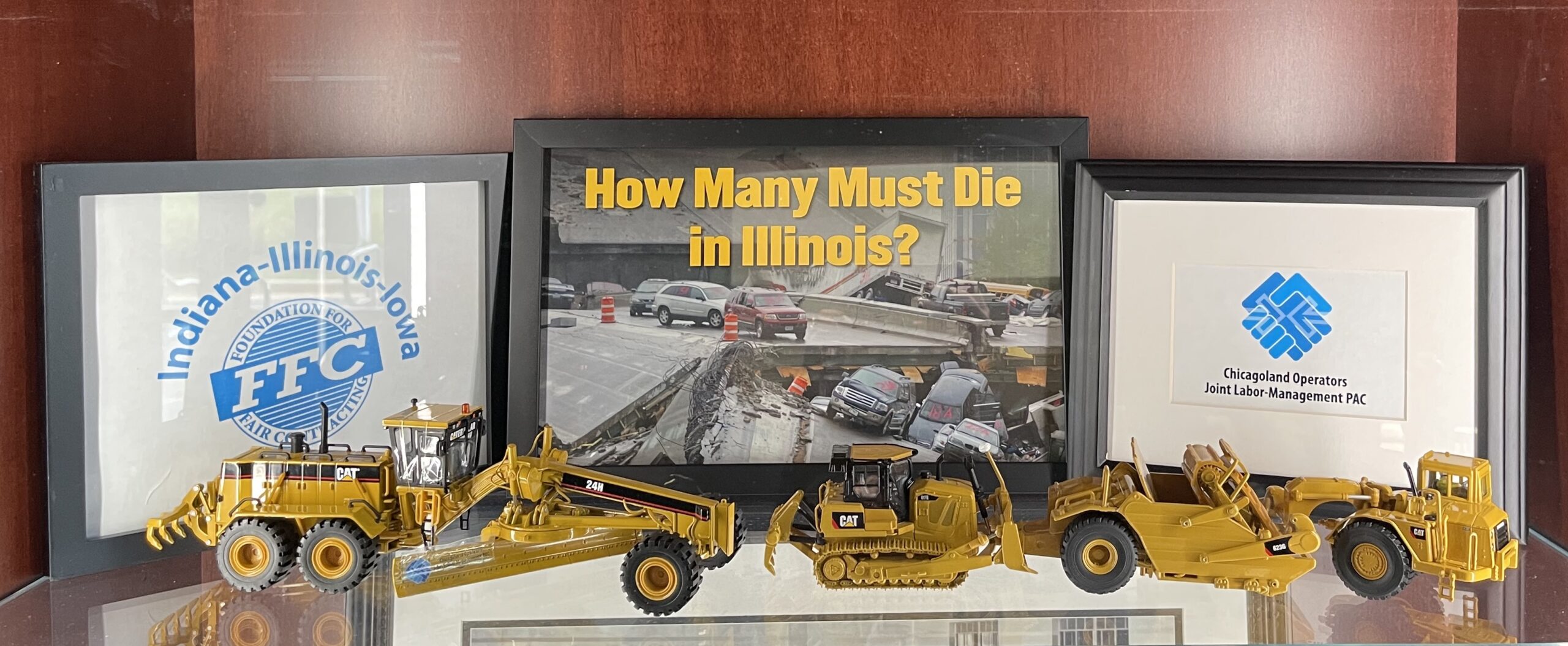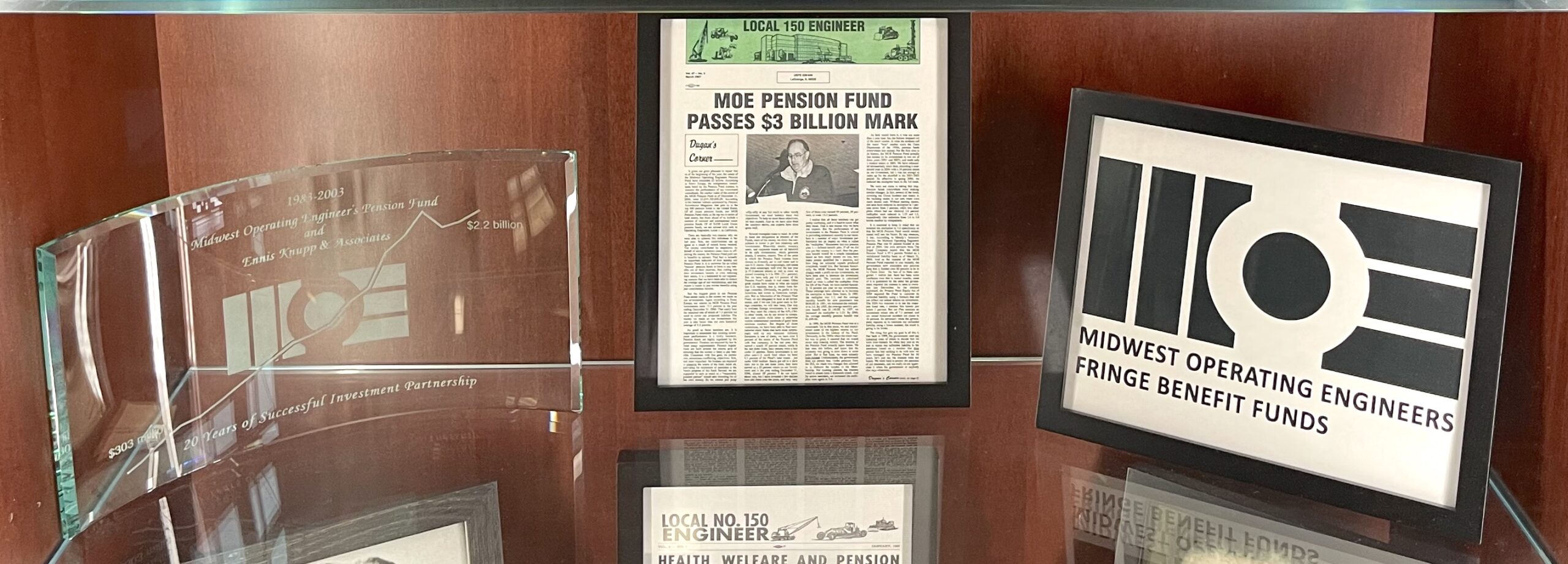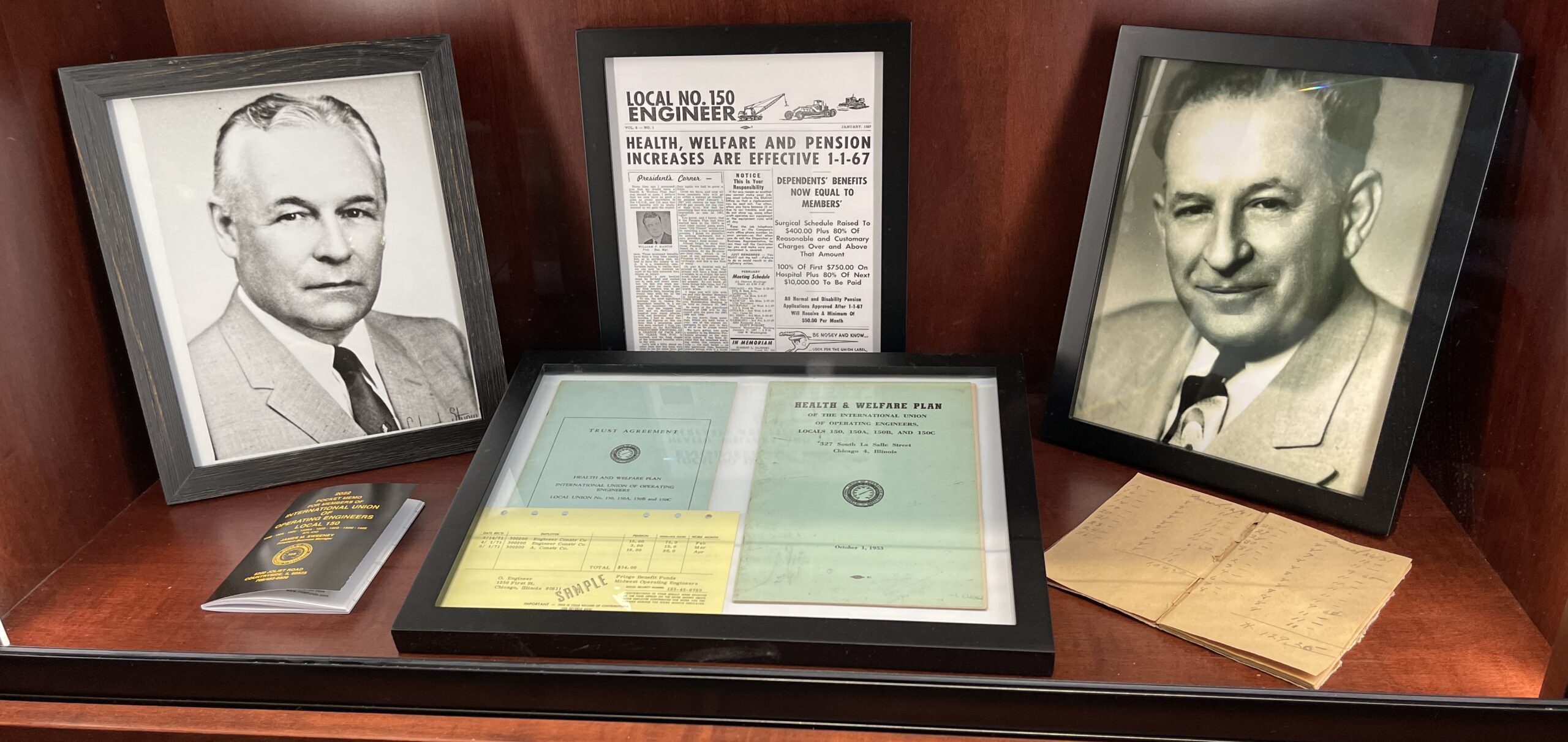
This display case is filled with Local 150 artifacts, photos, and memorabilia to illustrate the history of the union. The left side of the case is broadly devoted to labor management materials that illustrate the Midwest Operating Engineers trust funds, as well as Joint Labor Management Programs including the Indiana, Illinois, Iowa’s Foundation for Fair Contracting (IIIFFC) and the Chicagoland Operators PAC. The right side tells the story of the union. From bottom to top, it tracks the origin of Local 150 in 1929 through the various administrations of our President-Business Managers. Please read below to learn more about the contents of the shelves before you.
Above the Case: “The Safe Roads Amendment” yard sign promoted the signature achievement and culmination of the nearly century-old goal of creating a “lockbox” to fund transportation infrastructure. On November 8, 2016, Illinois voters overwhelmingly passed the Illinois Transportation Taxes and Fees Lockbox Constitutional Amendment, also known as the Safe Roads Amendment.

Top Left Shelf
Top Left Shelf:
- FFC logo: IIIFFC was established in 1995 to monitor publicly funded construction projects to ensure payment of prevailing wages under state and federal laws. Jointly administered by management and labor, its primary goal is to establish a level playing field in public construction protecting both employees and their employers from unfair competition.
- Chicagoland Operators PAC logo: The Chicagoland Operators PAC was established in 2010 to promote infrastructure investment in Illinois. Like the IIFFC, it is a joint management-labor program governed by the Midwest Operating Engineers Construction Industry Research and Service Trust Fund (CRF)
- “How Many More Must Die in Illinois” was a targeted mailer sent to Illinois voters to alert them of the voting rewards of State Senators and Representatives who opposed investment infrastructure.
- The Chicagoland Operators PAC Die Cast models: In conjunction with Local 150 and the Illinois Utilities Alliance, the PAC sponsors an annual reception for Illinois legislators. Die Cast models of construction equipment sporting the logo are customarily awarded to our legislative supporters.

Second Shelf on the Left
Second Shelf on the Left:
- “The Captains of Industry” photograph of the Chicago Roadbuilders Association members dinner, circa Those pictured include the fathers and grandfathers of many construction contractors signatory to local 150 to this day. Minutes of the groups meeting include reference to their legislative goal of enacting statutory restrictions on expenditure of transportation related revenues to transportation construction-the “Lockbox”.
- The Die Cast models are trucks of some of Local 150’s largest signatory contractors.
 Third Shelf on the Left:
Third Shelf on the Left:
- On the left, is the logo that is currently used to identify the Local 150 Apprenticeship and Skill Improvement Program (ASIP).
- The center photograph is of the William E. Dugan Training Center located in Wilmington, Illinois. Opened in 2001, the ASIP site was build with over $50 million in Local 150 members’ dues money. The operation of the site is funded by employer contribution to the ASIP program. Training is free to Local 150 members and apprentices.
- The photograph on the right depicts the Union’s Bucyrus Erie steam shovel at the Local 150 Family Picnic at the Training Site. It was restored by Training Site Instructors and apprentice volunteers.
- The Die Cast model of a Palumbo Lowboy hauling an excavator are examples of vehicles and equipment Local 150 members and apprentices train on at the site. Apprentices are required to test for and obtain Commercial Drivers’ Licenses (CDL) necessary to transport equipment over the road. The operation of track back-hoe excavator in a piece of equipment tow-hitch, most apprentices are required to become proficient.

Fourth Shelf on the Left
Fourth Shelf on the Left:
- The glass plaque on the left commemorates the growth of the Midwest Operating Engineers Pension Fund when it reached $2 billion in assets.
- This Local 150 Engineer issue proudly announces a pension fund milestone.
- The MOE Pension Fund logo is on the right.

Bottom Left Shelf
Bottom Left Shelf:
- On the left is a photo of James P. Crane who served as Local 150 President-Business Manager from 1954 to 1962. Prior to that, he was part of the William Law Administration which established the Local 150 Health and Welfare Fund in the first of the union’s fringe benefits.
In 1958, Robert F. Kennedy serving as Chief Counsel to the U.S. Senate Committee investigating labor unions subpoenaed Crane to testify before the Committee. Crane testified candidly about various problems in the American Labor Movement, and the Committee thanked and excused him. That Committee’s work led in part to the passage of the Labor Management Reporting and Disclosure Act (LMRDA) of 1959, which granted oversight of internal union elections to the U.S. Department of Labor. Ironically, Crane lost his reelection bid in 1962 to William F. Martin in the first Local 150 election conducted under the new law. The DOL denied Crane’s appeal.
- On the right is a photo of William Law who was Local 150’s President-Business Manager from 1952 to 1954. Although short, it was under this tenure that the Union established its first fringe benefit fund. Under the Taft-Hartley Act passed in 1947, such funds must be administered jointly by management and labor under the Collective Bargaining Agreements they negotiate.
- The documents in the middle of the shelf are the original Health and Welfare Plan and Trust Agreements, dated 1953. The “yellow slip” accompanying the agreements was used to track employer contributions on behalf of members. For many years the 150 Engineer would exhort members to “check your yellow slips” to confirm contributions for hours worked were paid to the Funds. Today, members go to www.My 150.com for that purpose.
- The Local 150 Engineer dated January 1967, recaps the contributions negotiated into the union’s construction agreements in 1966: an increase in the Health and Welfare Contributions to 20 cents per hour, and the first-ever contribution to the Pension Fund of 10 cents per hour.

